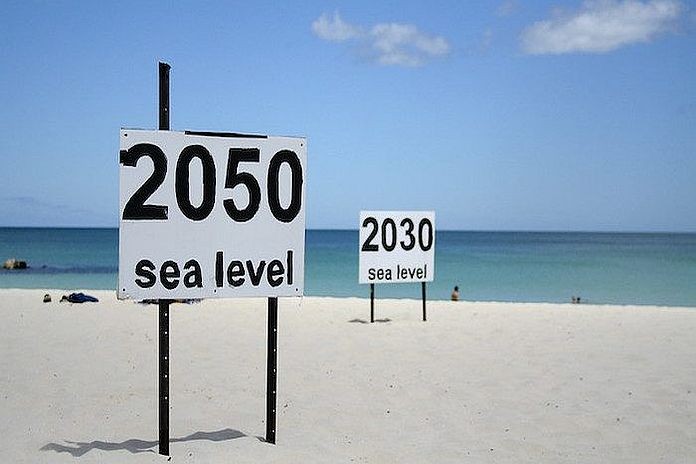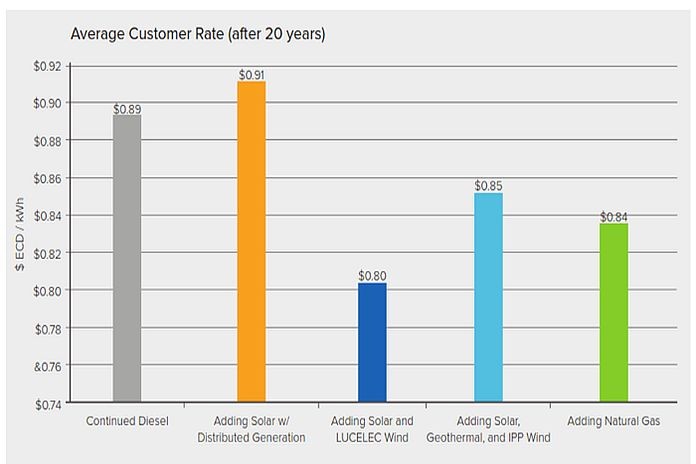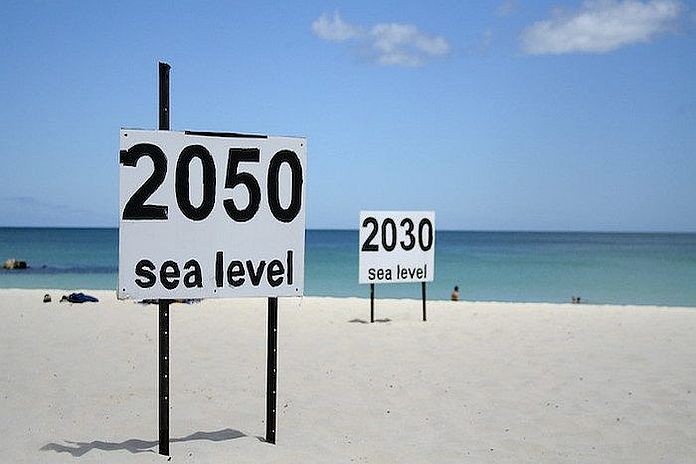Exploring renewables in St Lucia: Part 1

CASTRIES, St Lucia – The 2021 United Nations Climate Change Conference, better known as COP26, occurred from October 31st to November 13, 2021, in Glasgow, Scotland. Despite being delayed by a year, due to the COVID19 pandemic, the 26 Conference of the parties (COP) served as a platform for various parties to pledge commitments towards mitigating climate change. In the end, COP26 resulted in the Glasgow Climate Pact.
This was the first climate agreement to reducing coal consumption; encouraging immediate greenhouse gases emission reduction along with commitments to more climate financing for developing countries as they adapt to climate change impacts.
One of the more dramatic speeches to COP26, was delivered by Tuvalu’s (Pacific Island nation) Foreign Minister Simon Kofe. Bearing a suit and tie and with pants rolled up to his knees, Kofe stood in water which was formerly dry land. Tuvalu’s ocean levels are rising at 0.2 inches per year higher than the global average. Thus, this almost gives certainty that at some point in history that Tuvalu and its neighbours will be completely submerged in water. Similarly, one ponders what the future of small developing Caribbean Island nations (like St Lucia) will be and how will they respond to limit the impact of climate change such as rising sea levels, increased natural disasters and reduced tourism arrivals.
The following material will explore alternative (renewable) energy sources that are applicable to small island nations such as St Lucia. It should serve as supplemental material to the current initiatives that the St. Lucia’s government and its associates have had in the works.
Current state of energy affairs
St. Lucia’s sole electric utility company, St Lucia Electricity Services Limited (LUCELEC) has a customer base of roughly 61,000. LUCELEC major shareholders are as follows: Emera St Lucia Ltd. (20%), First Citizens Bank Limited (20%), National Insurance Corporation (NIC, 20%), Castries Constituency Council (CCC, 15.50%), Government of St Lucia (10.05%). LUCELEC has the capacity to provide 88.4 megawatts (MW) of power with peak demand being ~ 60 MW. The majority of the island’s electricity is generated from imported diesel fuel which powers electrical generators. In 2015, Saint Lucia’s electricity utility rates of $0.90XCD per kilowatt-hour (kWh) were on par with regional average ($0.89XCD/kWh). However, these rates are more than triple the US’s average electricity rates of ~$0.27XCD per KWh.
In February 2015, Saint Lucia’s energy snapshot indicated that despite the renewables making up less than 1% of the island’s energy sector, the goal was achieving 35% of the country’s energy generation from renewables by 2020. One could only assume that the advent of COVID-19 pandemic has further delayed this renewable dream. Caribbean islands have been blessed with an abundance of natural resources (like solar, wind, geothermal) and there is great potential for harnessing their energy to our benefit. Saint Lucians and climate change activists will be keenly awaiting the current’s government policy and strategy for implementing a ‘greener’ energy sector.
Geothermal energy
Geothermal energy is the heat energy stored inside the Earth and manifests itself in volcanoes, hot springs, and geysers. Geothermal offers vast potential for being more efficient than fossil-fueled power generation with no greenhouse gas emissions. Several eastern Caribbean islands of volcanic origin have explored and discussed geothermal energy for decades with only at Bouillante. In 2017, it was announced that Guadeloupe was expected to expand geothermal energy production to 50–60 MW in 4–5yrs.
It is expected that geothermal power would sell to Utilities for ~$0.12–0.15 less than the current cost of electrical generation. Hence, there is a potential savings for consumers, paying less per kWh for energy. For instance, in Guadeloupe, electricity is bought at a price lower than that of fossil-fueled generation and it is expected that consumers will save ~$68 million US in electricity bills over a 9-yr period. Some draw backs to geothermal energy include: requiring significant due diligence with specialized experts, high immediate capital costs, and large-scale structures to develop and long lead times.
There is hope for geothermal energy generation in Saint Lucia, with the World Bank approving a US $21.9 million fund for geothermal energy exploration in St. Lucia in July 2021. The following was mentioned during this press release: “This project will help the country evaluate how geothermal energy can contribute to the country’s national energy mix. Clean energy from geothermal sources can improve electricity system reliability and reduce the cost of oil imports. Transitioning to renewable energy would also decrease the country’s vulnerability to the volatility of fuel markets.” said Lilia Burunciuc, World Bank Country Director for the Caribbean. “The future development of geothermal energy, informed by the activities financed by this project, will translate into lower electricity costs for households and businesses.”
In 2018, it was indicated that an update was provided to the government of Saint Lucia. “A meeting earlier this week briefed Ministers of Cabinet for St. Lucia on the Geothermal Resource Development Project to inform on what the Government of Saint Lucia (GoSL) needs to action to advance the project to the next phase of exploratory drilling.”
What is the latest update on this geothermal project and what is the current government’s plan for hastening it, while addressing geothermal exploration concerns? Geothermal energy exploration discussions in Saint Lucia have been rumoured to take place since the 1960s.
Solar energy
Not surprisingly, Saint Lucia has an abundance of sunshine which also means high potential for solar energy generation. LUCELEC’s 3MW Solar farm in Vieux Fort has been providing solar energy to Saint Lucia’s electricity grid since April 2018. This renewable achievement is the single largest of its kind on the island and came at a cost of $20 million. “The 3 megawatt solar farm will generate 7 million kilowatt-hours (or units) of electricity per year, which is about 1.3 percent of the electricity generated from LUCELEC’s Cul De Sac Power Plant. It will reduce the annual volume of fuel purchased by LUCELEC by about 300 thousand gallons. LUCELEC uses approximately 19 million gallons of fuel per year.”
Potential drawbacks to solar energy generation include high initial capital costs, high maintenance cost, high land usage for solar panel installation and intermittency, with potential for a reduction in power generation during the cloudy periods.
Will LUCELEC and the current administration look to expand this solar farm to improve the contribution of renewables to Saint Lucia’s grid? Has the 25kW cap on renewable energy systems for commercial entities been lifted to allow greater solar power generation by other entities in Saint Lucia?
Wind energy
Back in 2016, much was documented regarding a 12MW wind farm to be implemented in Dennery. “The 12MW wind farm will be the first of its kind in Saint Lucia. It will consist of four (4) turbines erected on the ridge near the Bordelais Correctional Facility. At full capacity, it will generate enough energy to power approximately 19, 475 homes. Its output will be equivalent to the production power of one of LUCELEC’s ten diesel engines. The wind farm is projected to reduce the amount of fuel purchased by the company by about ten percent (10%).”
This project appeared to hit a roadblock with developers “pulling out”, with then Minister of Sustainability claiming the following: “It is therefore astonishing that the developer has decided to pull out from the proposed project without allowing the process to proceed. As a government we are deeply disappointed, however, the Government of Saint Lucia is pleased to announce that it is pursuing a suite of new proposals for renewable energy projects, which includes the development of a wind farm,” said Dr Rigobert, who has responsibility for renewable energy development on the island.
The Latest press release in 2018 indicated the following after developers met with the government at the time: “The meeting provided a platform to discuss and resolve challenges and barriers to continued development of the wind farm. It was also an opportunity for government to reaffirm its commitment to the development of wind energy. A Cabinet Memorandum will be submitted, and government is considering land acquisition, concessions and other contributions for the advancement of the project. The energy minister has assured that government will support the project once it redounds to the benefit of the ordinary man.”
Can the current government of Saint Lucia provide any updates on this initiative? Are there any plans to revisit this wind project?
A plan for the future of renewables in St Lucia?
The Saint Lucia Energy Roadmap report (2016) provided a detailed economic assessment of several potential future scenarios for renewables in Saint Lucia. The figure below shows that the scenario with the lowest customer rates ($0.80 XCD per kWh) would be achieved by adding a combination of solar and wind energy. There is also potential for customer rate savings by adding Solar, Geothermal, and Wind ($0.85 XCD per kWh) versus continued Diesel (~$8.89XCD per kWh).

Conclusion
Saint Lucia, which is a non-oil producing nation, has primarily relied on fossil fuel importation for electricity generation. The largest source of greenhouse gases emission continues to be the burning of fossil fuels for electricity. Furthermore, Saint Lucia continues to be at the mercy of global oil prices; with the consumer paying electrical rates nearly triple that paid in the US.
Current leaders will need to urgently implement renewable power generation initiatives if they are to address the concerns of rising sea levels along with savings to consumers. Geothermal, Solar and Wind energy have already been documented as potential renewable energy generation sources in Saint Lucia. These initiatives have remained quietly in the hands of technocrats with little public updates or progress shown.
The question that now begs us — when will we transition into a ‘greener energy’ market?
Source: The St Lucian Analyzer
Source: caribbeannewsglobal.com



